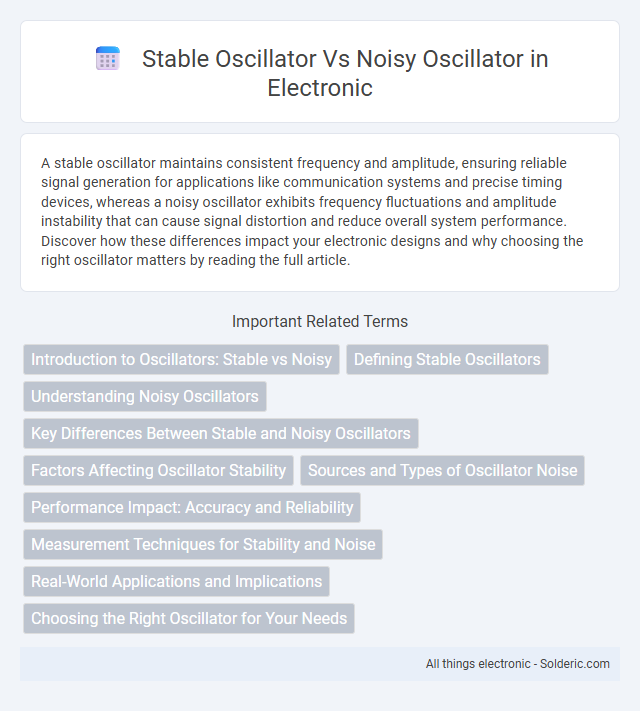A stable oscillator maintains consistent frequency and amplitude, ensuring reliable signal generation for applications like communication systems and precise timing devices, whereas a noisy oscillator exhibits frequency fluctuations and amplitude instability that can cause signal distortion and reduce overall system performance. Discover how these differences impact your electronic designs and why choosing the right oscillator matters by reading the full article.
Comparison Table
| Feature | Stable Oscillator | Noisy Oscillator |
|---|---|---|
| Signal Quality | High precision, low phase noise | Low precision, high phase noise |
| Frequency Stability | Consistent frequency over time and conditions | Frequency fluctuates unpredictably |
| Application | Clocks, communication systems, measurement devices | Simulations, noise testing, random signal generation |
| Output Signal | Clean sine wave or stable waveform | Distorted or erratic waveform |
| Energy Efficiency | Optimized for low power consumption | Generally less efficient |
| Dependability | Highly reliable for precision tasks | Unreliable for time-critical operations |
Introduction to Oscillators: Stable vs Noisy
Stable oscillators deliver consistent frequency and amplitude, essential for precise communications and signal processing applications. Noisy oscillators generate fluctuating signals with phase noise and amplitude variations, causing signal distortion and reduced system performance. Understanding the trade-offs between stability and noise is critical for designing efficient electronic circuits and timing devices.
Defining Stable Oscillators
Stable oscillators produce consistent, fixed-frequency signals with minimal phase noise, ensuring reliable performance in communication systems and timing applications. Their design minimizes frequency drift due to temperature changes, power supply variations, and component aging. High-quality quartz crystal oscillators exemplify stable oscillators, offering precise frequency control critical for radio transmitters and frequency synthesizers.
Understanding Noisy Oscillators
Noisy oscillators exhibit random fluctuations in amplitude and frequency due to inherent thermal noise and device imperfections, significantly impacting signal stability and performance in communication systems. These fluctuations can degrade phase noise characteristics, leading to reduced coherence and increased jitter in applications like RF circuits and signal generators. Understanding the noise sources and mechanisms in noisy oscillators is crucial for designing filters and compensation techniques that enhance overall oscillator reliability and signal integrity.
Key Differences Between Stable and Noisy Oscillators
Stable oscillators maintain a consistent frequency and amplitude, ensuring precise timing and reliable signal generation essential for applications like communication systems and clocks. Noisy oscillators exhibit fluctuations in frequency and amplitude due to internal or external disturbances, leading to signal degradation and reduced performance in sensitive electronic circuits. Understanding the differences between stable and noisy oscillators helps you select the right oscillator type to optimize system accuracy and minimize signal distortion.
Factors Affecting Oscillator Stability
Oscillator stability is primarily influenced by factors such as temperature variations, component quality, and circuit design. Stable oscillators use high-quality quartz crystals with low aging rates and temperature-compensated circuitry to minimize frequency drift. In contrast, noisy oscillators suffer from poor component tolerances, thermal noise, and power supply fluctuations, resulting in irregular frequency output and phase noise.
Sources and Types of Oscillator Noise
Oscillator noise primarily originates from thermal fluctuations, flicker noise, and phase jitter inherent in electronic components such as transistors and resistors. Stable oscillators minimize these noise sources through high-quality components and precise circuit design, yielding low phase noise and frequency stability. Understanding your system's sensitivity to oscillator noise is crucial when selecting between stable and noisy oscillators for optimal signal integrity.
Performance Impact: Accuracy and Reliability
A stable oscillator delivers consistent frequency output, enhancing the accuracy and reliability of your electronic systems by minimizing signal jitter and phase noise. In contrast, a noisy oscillator introduces frequency fluctuations that degrade signal integrity, leading to timing errors and reduced performance. Choosing a stable oscillator ensures higher precision in applications like communication, navigation, and measurement, where dependable signal quality is critical.
Measurement Techniques for Stability and Noise
Measurement techniques for stable oscillators involve phase noise analyzers and frequency counters to precisely quantify low phase noise and minimal frequency drift. In contrast, noisy oscillators require spectrum analyzers and time-domain jitter measurements to detect high phase noise and amplitude fluctuations. Understanding these measurement tools enables you to accurately assess oscillator performance and optimize your system's frequency stability.
Real-World Applications and Implications
Stable oscillators are crucial in telecommunications, ensuring consistent signal frequency for reliable data transmission in mobile networks and satellite communication. Noisy oscillators introduce phase noise and frequency jitter, which can degrade signal quality in sensitive applications such as radar systems and precision instrumentation. Your choice between stable and noisy oscillators directly impacts the performance and accuracy of devices in aerospace, medical equipment, and consumer electronics.
Choosing the Right Oscillator for Your Needs
Choosing the right oscillator depends on your application's sensitivity to frequency stability and noise levels. Stable oscillators, such as crystal oscillators, provide precise frequency control essential for communication systems and instrumentation, while noisy oscillators are suitable for less critical applications where some signal variability is acceptable. Your decision should weigh factors like phase noise, temperature tolerance, and power consumption to ensure optimal performance and reliability.
Stable oscillator vs Noisy oscillator Infographic

 solderic.com
solderic.com